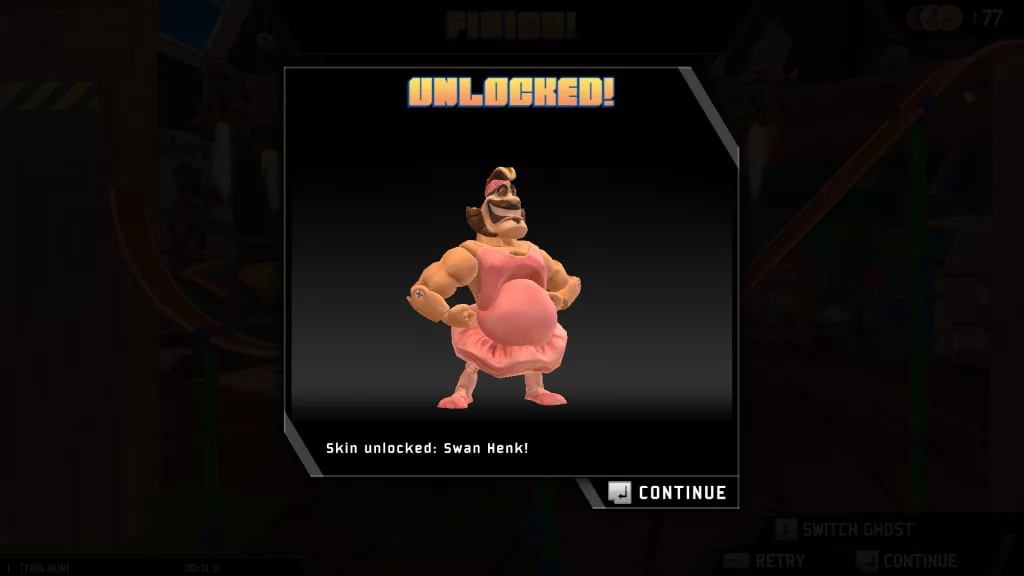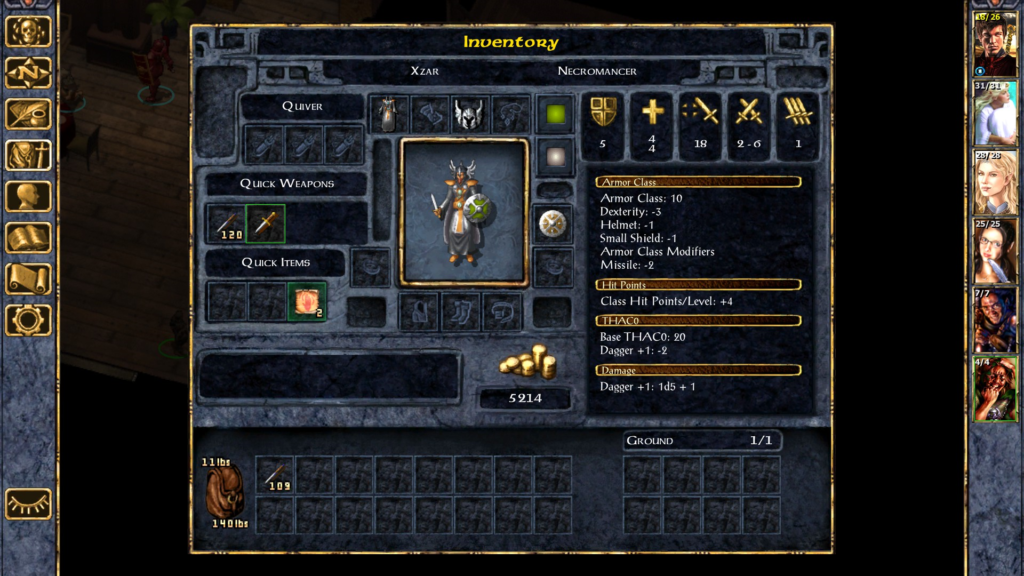My mission to finish all games in my Steam Library is moving at a slow pace. Lately I’ve been playing a lot of Action Henk, earning medals and unlocking skins. It’s gotten me thinking about skins in games, and how they have changed over the years.
Challenges
Action Henk provides many challenges that allow you to unlock new characters and skins. I’ve learned that by getting a gold in all courses for a chapter, you unlock a bonus stage. This stage is different to the others: you race against the clock trying to collect all the coins around the stage.

In a normal course you have the route provided for you. You generally keep moving forward until you get to the end. Slowly improving your technique until you can move forward fast enough to earn a medal, or beat another player’s time.
In the challenges you have to get creative. You have to first figure out your own, optimised route, to get to the coins quickly enough. Then, when you think you have a route that works, you have to keep repeating it until you do it fast enough to get all the coins.
It’s easy to doubt yourself. Will this route really work? Am I just not doing it fast enough, or do I need a different approach? It’s a very different challenge to the usual races.

If you do manage to complete the challenge, you are rewarded. A new costume is yours to play with! Equipping this skin allows you to not only play as a different character, but also to show other players that you have completed the challenge. While the actual gameplay doesn’t change, it still gives you a feeling of satisfaction when you are rewarded for completing a challenge.
Skin
Custom skins have been a thing in video games for a long time. Games released on the first Playstation would have unlockable skins. My earliest memory is probably by beating the first ever Resident Evil to get a key you can use in the next playthrough, gaining you access to a wardrobe where you could change your character’s outfit.
In Baldur’s Gate, probably my favourite game of all time, one of the aspects I really enjoy is upgrading my character’s equipment and seeing what they look like with it, be it wizard robes, heavy armour, flaming swords, or bows. You can customise your character from the beginning, but by playing through the game, one of its rewards are the new “skins” you can give your characters by upgrading their equipment.

It’s been a mechanic in games for pretty much as long as graphics have been able to support it. When I was raised dolls were considered a “girl’s thing”, but character customisation, equipment you can see on your characters, and skin unlocks as rewards tell us that we all like to play dress up. Game designers know this, and it’s no accident that games use skins as a reward.
Another thing that skins did in multiplayer games (and especially in MMOs), was to show that players had completed certain challenges. By wearing a certain piece of equipment or costume you could show off to other players the things you had done in that game. It’s a diegetic way of showing off a player’s progress.
You Already Know This Bit
I’m not the first person to ever write about this, so you likely know what I’m about to mention. Because you can’t talk about this topic without mentioning Horse Armor.
Morrowind was a game in the Elder Scrolls series developed by Bethesda. Like Baldur’s Gate, Starcraft, and many other games before it, there were two expansion packs (what we now call DLC) released for it: Tribunal and Bloodmoon.
And like those games that came before it, these expansions added whole new areas of the game to explore, new characters, stories, equipment, and even new mechanics. While they weren’t as large as the core game, they were essentially full games in and of themselves, extending the play time by several dozen hours.
It’s sequel, Oblivion, would be the first game to test the waters. While it did release a full expansion (Shivering Isles), it also released several smaller plugins that were cheaper and added minimal content to the game. The most infamous of these was Horse Armor.
This plugin added the ability to equip armour on your horses. But it was purely cosmetic. There were no mechanical advantages to equipping it, it just looked different. The response from gamers was rather impolite.
What was the point? Paying for something that adds no gameplay? For something a modder could whip in a week? Did they just remove a minor feature from the game to try and suck extra money from people?
People were angry about this. The backlash was so harsh that it seemed like no company would ever do this again. It was seen as an extremely dumb move by many, but one that would disappear into the annals of gaming history. Hey remember when that game company tried to charge people for an outfit?
But that wasn’t the punchline to this joke. The thing about people that shout things on the internet is that they tend to be part of a vocal minority. The thing that people didn’t notice would be something that would change the direction of the games industry forever.
You see, despite the vocal backlash, people actually paid real money to get a purely cosmetic outfit for their horse in a video game.
As Long as it’s Only Cosmetics
While horse armour can mark the start of a cultural shift in games, it wasn’t the first game to do something like this. MapleStory had been around for a long time and, while it was very popular in South Korea and Asia, it only really had a niche following in the Western world.
One of the core ideas of this game was that none of the mechanics of the game could be altered with real money. You get a big powerful sword, you have a big powerful sword. But if you wanted it to look different, you had to pay for the skin. So, mechanically the sword would still do 100, 1,000, or 10,000 damage if you didn’t pay, it just wouldn’t look cool.
Also, the core game was free. You only had to pay if you wanted to look cool. While people playing Oblivion were complaining about having to pay for something that was purely cosmetic, people playing MapleStory were praising it for only charging for things that were purely cosmetic.
When publishers started to realise that people would pay for skins, games started shifting in a different direction. No longer would you unlock skins by completing challenges, you could unlock them with real money.
As games started to push the bar higher and higher, there was backlash. Companies would assure players by saying content could be unlocked by either playing the game or by paying, so that no one was really locked out of anything. When EA was called out for how unrealistically long players would need to grind to get said content, it led to the most downvoted comment in reddit’s history.
But the punchline was the same. Despite any backlash, people still kept paying for their skins. For many younger gamers, this is pretty much the norm now. There’s nothing wrong with selling in game content any more. As long as it doesn’t affect gameplay. As long as it’s only cosmetics.
Default
I recently learned of a new insult that gets thrown around. I turned 40 this year, and that officially means I’m not down with kids anymore, so this insult is new to me. But it’s one you will hear in free to play games that sell custom skins.
Default
/dɪˈfɔːlt,ˈdiːfɔːlt/
INFORMAL
noun
- A person who plays a multiplayer video game using only the default skins.
“You’re just a boring default.”
verb
- Someone who is using a default skin in a video game.
“Kenny’s so poor, he defaults.”
It’s pretty much become embarrassing for kids to use default skins these days. Instead of begging parents for new toys, kids will be begging for skins in a video game. It’s not just normal, it’s expected that you will pay for and play with a skin if you want to participate in a free to play game these days.
What’s lost is that sense of achievement for completing a challenge. The story when you see someone wearing something because you know what they had to do to earn it. Now the skin reflects only the size of your wallet (or that of your parents). And you will get bullied if you are not rich enough.
The next generation of gamers will probably grow up to accept this as normal. They will see nothing wrong with paying for cosmetics in a video game.
As long as it’s only cosmetics.





